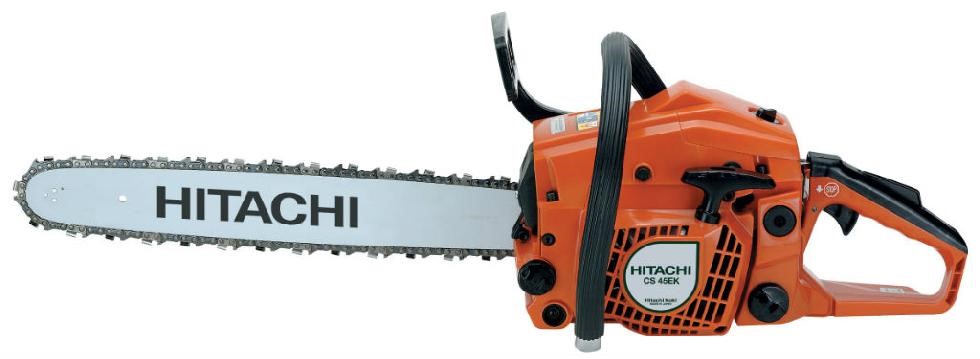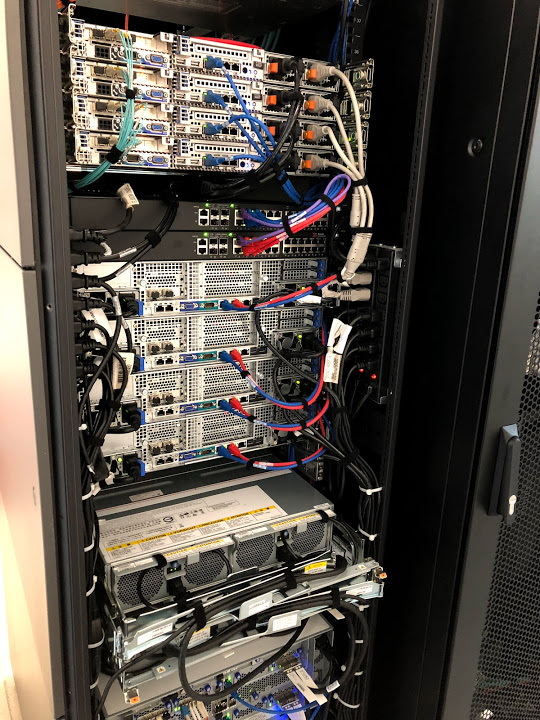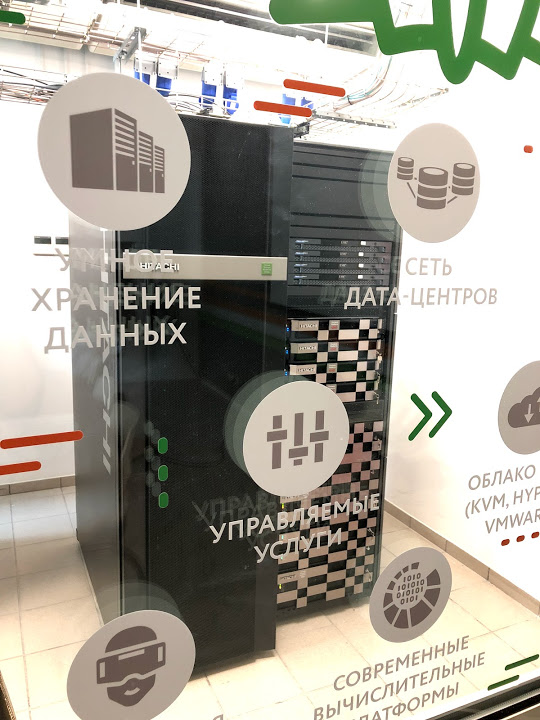Hitachi: how the Japanese sunk from chainsaws to modern storage systems
When I hear Hitachi, I immediately think about something like this:

Or about the fridge. Or about the locomotive. But not about storage. But no, the Japanese make big serious data storage systems:
')

We recently opened the training center Hitachi Vantara , where we tell you exactly what to do with these storage systems and how to do it. So far only the first month of classes has been completed, so now I will not tell about the training center - I’ll share the info later. Just add that it works on the basis of CROC OK, where we do online courses on IT and not only. I was much more interested in why the Japanese even went to this area.
Need to start in 1910. It was then at the mine in the city of Hitati appeared a guy named Odair. In about 10 years he, from a young engineer, became the head of the technical department of the mine.
Then somehow it happened that he needed to assemble an electric motor for the mine. In 1910, he collected and launched it. The sound of the working engine made it clear that this is the first such device in Japan. It immediately became clear that at the mine it would be very useful - and not only at the mine. He will need the whole country. Despite its 5 horsepower. Therefore, Namikhei Odair founded what would become the Hitachi Industrial and Commercial Association in the future.
At the start, no one bought from him, because the Japanese thought that the Japanese equipment was something like our “sharash-montazh”, that is, it was assembled in the garage on the knee and would not work. There was still no history of Mitsubishi, Panasonic, there was nothing for which a Japanese resident would be proud of the technical progress of his country. So Odair and died in obscurity, if not the First World. Japan did not receive supplies from the "mainland", and eventually had to buy local. Odair was very accelerated and worked at the Stakhanov pace in assembling new models. When it became clear that his devices were working and failing not as often as was expected intuitively, great demand came from industry.
Next is an office in Tokyo and trademark registration. Prior to the Second World Odair, I really wanted to remain a peaceful company (but then somehow did not grow together).
Another 6 years - they collected the first AC locomotive. The 40th is a big PBX. Then the war, but the company becomes the flagship of recovery. Odair, by the way, the Americans removed from the management of the company for 3 years, closed 19 factories and almost brought the group to bankruptcy. Then he came back and started burning again, but not for very long - he was already an old grandfather. The newer, younger director immediately realized that he had to dig in the direction of electronics, and sent a lot of people to adopt RCA and General Electric technologies. Until the 73rd year, the topics of economic development in Japan after the war were very high, and Hitachi perfectly caught the wave.
1952 - the first air conditioner. The 70th is the first automated process control system, a system for the railway, almost a full-fledged computer. 74th year - and why not release computers? Here is the first. From this point on, they clearly stand on the rails of the technological leader of the country and do not move out of them to this day. 84th - look, we can make RAM modules. Hitachi turned out to be an excellent competitor to IBM, which did not allow the latter to overcharge, so the global IT community was interested in the welfare of both companies.
In the 1980s, they rediscovered PR and marketing. 85th — a total of 30 million power tools were produced. 2001 is also software, document management system for the state. 2011 - sold the unit for the production of HDD Western Digital. 2012 - stopped making televisions. 2017 - sold power tools division.
Throughout history, they managed to assemble planes and engines for them, onboard systems of automobiles, batteries, LCD screens, excavators, cranes and a whole bunch of mines, military transport workers, satellite subsystems, equip reconnaissance centers, file down equipment for infantry fighters, do washing machines, air conditioners and refrigerators, finance and insurance, develop a bunch of new materials for application in their civilian and military products, pick up ATMs, servers, server clusters, telecom equipment and write on Goa from this software as a firmware level, and applied. They are involved in nuclear power in Japan and in green power too. Their elevators transport as many people per day as metro in Japan.
Now the company employs a little more than 300 thousand people. Approximately 17 thousand of them are scientists who work in dozens of laboratories around the world. A couple of years ago, the budget for science was about 1/20 of the corporate budget. There are almost no medium-sized companies in Japan - several concerns control entire segments of the economy and absorb medium-sized companies in time. Therefore, around Hitachi there is still a whole "asteroid belt" from small companies and startups, where they run in the craziest ideas.
In general, a company with a Japanese sense of purpose goes forward in new technologies and tries to get rid of everything that slows it down. Over the years, the share of turnover in the server park (more precisely, everything that is used in data centers) in the company is growing, and it is clear that interests are concentrated somewhere in this area.
Hitachi Vantara is a relatively new company in the corporation. It deals only with data solutions (read - data center equipment and software), in fact - a storage vendor. They are very actively interacting with other companies within Hitachi Corporation and just as quickly open offices around the world. In Russia, this is our training center, in particular. We, as an integrator, have been cooperating with them for a long time, so the decision to open a platform for training in Moscow is quite logical.
Here is the storage system itself:

Hitachi content platform
Two VSP G 600 Unified Platform with NAS blades
Virtual Storage Platform G1500
Training - courses on a couple of days on the Hitachi Content Platform (HCP), Hitachi Virtual Storage Platform G (VSP) G level Mid-range and Enterprise, Hitachi NAS Platform (HNAS). More courses on working with software for managing and configuring equipment - Hitachi Command Suite, practical mastering of Global Active Device technology, which allows you to create a distributed active-active cluster on VSP G data storage systems, as well as courses for storage architects aimed at correct design and VSP storage performance optimization. The trainers are certified by Hitachi, each is a practicing engineer, behind whom are many completed projects and experience in servicing the supplied systems.

Or about the fridge. Or about the locomotive. But not about storage. But no, the Japanese make big serious data storage systems:
')

We recently opened the training center Hitachi Vantara , where we tell you exactly what to do with these storage systems and how to do it. So far only the first month of classes has been completed, so now I will not tell about the training center - I’ll share the info later. Just add that it works on the basis of CROC OK, where we do online courses on IT and not only. I was much more interested in why the Japanese even went to this area.
Need to start in 1910. It was then at the mine in the city of Hitati appeared a guy named Odair. In about 10 years he, from a young engineer, became the head of the technical department of the mine.
From the miner to IT
Then somehow it happened that he needed to assemble an electric motor for the mine. In 1910, he collected and launched it. The sound of the working engine made it clear that this is the first such device in Japan. It immediately became clear that at the mine it would be very useful - and not only at the mine. He will need the whole country. Despite its 5 horsepower. Therefore, Namikhei Odair founded what would become the Hitachi Industrial and Commercial Association in the future.
At the start, no one bought from him, because the Japanese thought that the Japanese equipment was something like our “sharash-montazh”, that is, it was assembled in the garage on the knee and would not work. There was still no history of Mitsubishi, Panasonic, there was nothing for which a Japanese resident would be proud of the technical progress of his country. So Odair and died in obscurity, if not the First World. Japan did not receive supplies from the "mainland", and eventually had to buy local. Odair was very accelerated and worked at the Stakhanov pace in assembling new models. When it became clear that his devices were working and failing not as often as was expected intuitively, great demand came from industry.
Next is an office in Tokyo and trademark registration. Prior to the Second World Odair, I really wanted to remain a peaceful company (but then somehow did not grow together).
Another 6 years - they collected the first AC locomotive. The 40th is a big PBX. Then the war, but the company becomes the flagship of recovery. Odair, by the way, the Americans removed from the management of the company for 3 years, closed 19 factories and almost brought the group to bankruptcy. Then he came back and started burning again, but not for very long - he was already an old grandfather. The newer, younger director immediately realized that he had to dig in the direction of electronics, and sent a lot of people to adopt RCA and General Electric technologies. Until the 73rd year, the topics of economic development in Japan after the war were very high, and Hitachi perfectly caught the wave.
1952 - the first air conditioner. The 70th is the first automated process control system, a system for the railway, almost a full-fledged computer. 74th year - and why not release computers? Here is the first. From this point on, they clearly stand on the rails of the technological leader of the country and do not move out of them to this day. 84th - look, we can make RAM modules. Hitachi turned out to be an excellent competitor to IBM, which did not allow the latter to overcharge, so the global IT community was interested in the welfare of both companies.
In the 1980s, they rediscovered PR and marketing. 85th — a total of 30 million power tools were produced. 2001 is also software, document management system for the state. 2011 - sold the unit for the production of HDD Western Digital. 2012 - stopped making televisions. 2017 - sold power tools division.
Throughout history, they managed to assemble planes and engines for them, onboard systems of automobiles, batteries, LCD screens, excavators, cranes and a whole bunch of mines, military transport workers, satellite subsystems, equip reconnaissance centers, file down equipment for infantry fighters, do washing machines, air conditioners and refrigerators, finance and insurance, develop a bunch of new materials for application in their civilian and military products, pick up ATMs, servers, server clusters, telecom equipment and write on Goa from this software as a firmware level, and applied. They are involved in nuclear power in Japan and in green power too. Their elevators transport as many people per day as metro in Japan.
Now the company employs a little more than 300 thousand people. Approximately 17 thousand of them are scientists who work in dozens of laboratories around the world. A couple of years ago, the budget for science was about 1/20 of the corporate budget. There are almost no medium-sized companies in Japan - several concerns control entire segments of the economy and absorb medium-sized companies in time. Therefore, around Hitachi there is still a whole "asteroid belt" from small companies and startups, where they run in the craziest ideas.
In general, a company with a Japanese sense of purpose goes forward in new technologies and tries to get rid of everything that slows it down. Over the years, the share of turnover in the server park (more precisely, everything that is used in data centers) in the company is growing, and it is clear that interests are concentrated somewhere in this area.
What is the story with the storage system?
Hitachi Vantara is a relatively new company in the corporation. It deals only with data solutions (read - data center equipment and software), in fact - a storage vendor. They are very actively interacting with other companies within Hitachi Corporation and just as quickly open offices around the world. In Russia, this is our training center, in particular. We, as an integrator, have been cooperating with them for a long time, so the decision to open a platform for training in Moscow is quite logical.
Here is the storage system itself:

Hitachi content platform
Two VSP G 600 Unified Platform with NAS blades
Virtual Storage Platform G1500
Training - courses on a couple of days on the Hitachi Content Platform (HCP), Hitachi Virtual Storage Platform G (VSP) G level Mid-range and Enterprise, Hitachi NAS Platform (HNAS). More courses on working with software for managing and configuring equipment - Hitachi Command Suite, practical mastering of Global Active Device technology, which allows you to create a distributed active-active cluster on VSP G data storage systems, as well as courses for storage architects aimed at correct design and VSP storage performance optimization. The trainers are certified by Hitachi, each is a practicing engineer, behind whom are many completed projects and experience in servicing the supplied systems.
Source: https://habr.com/ru/post/352292/
All Articles